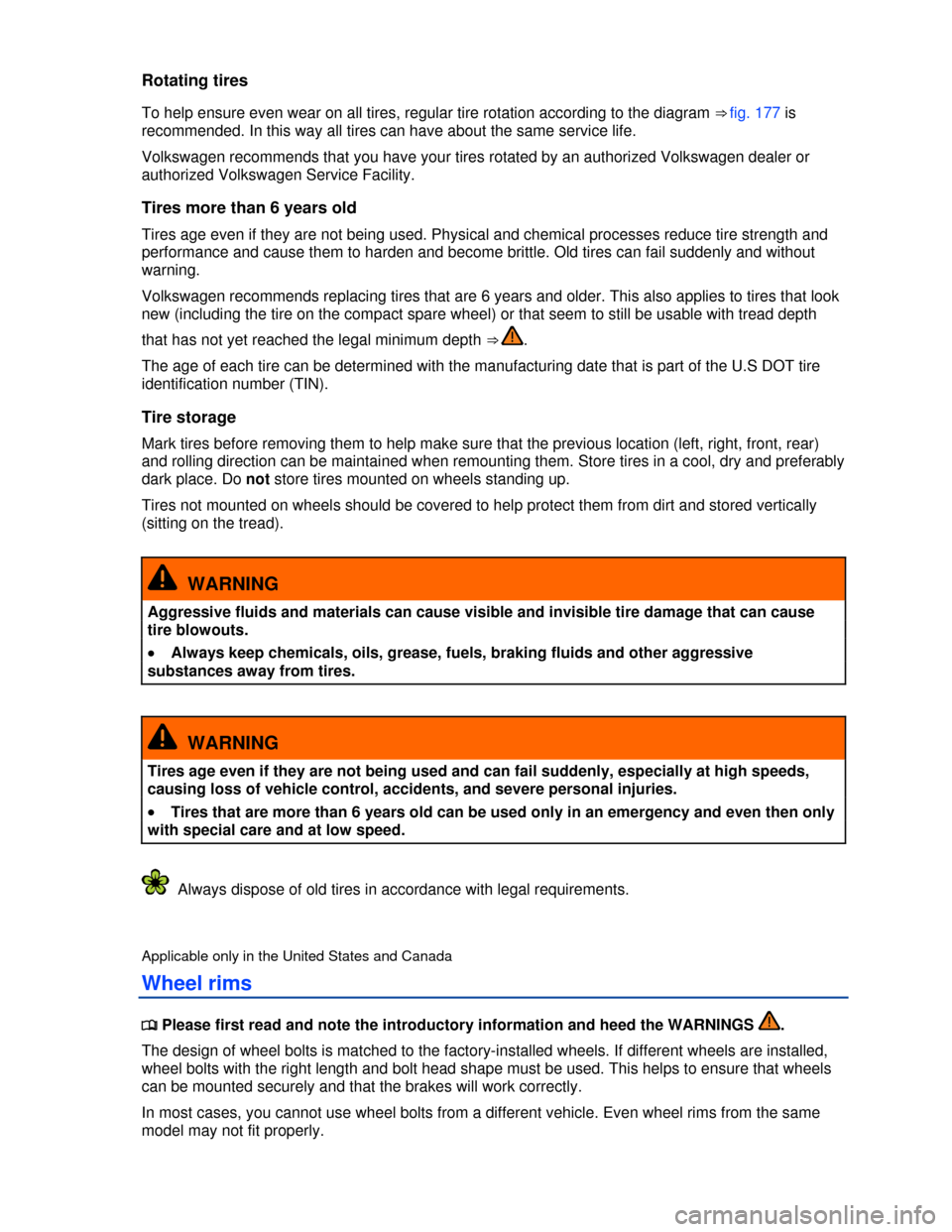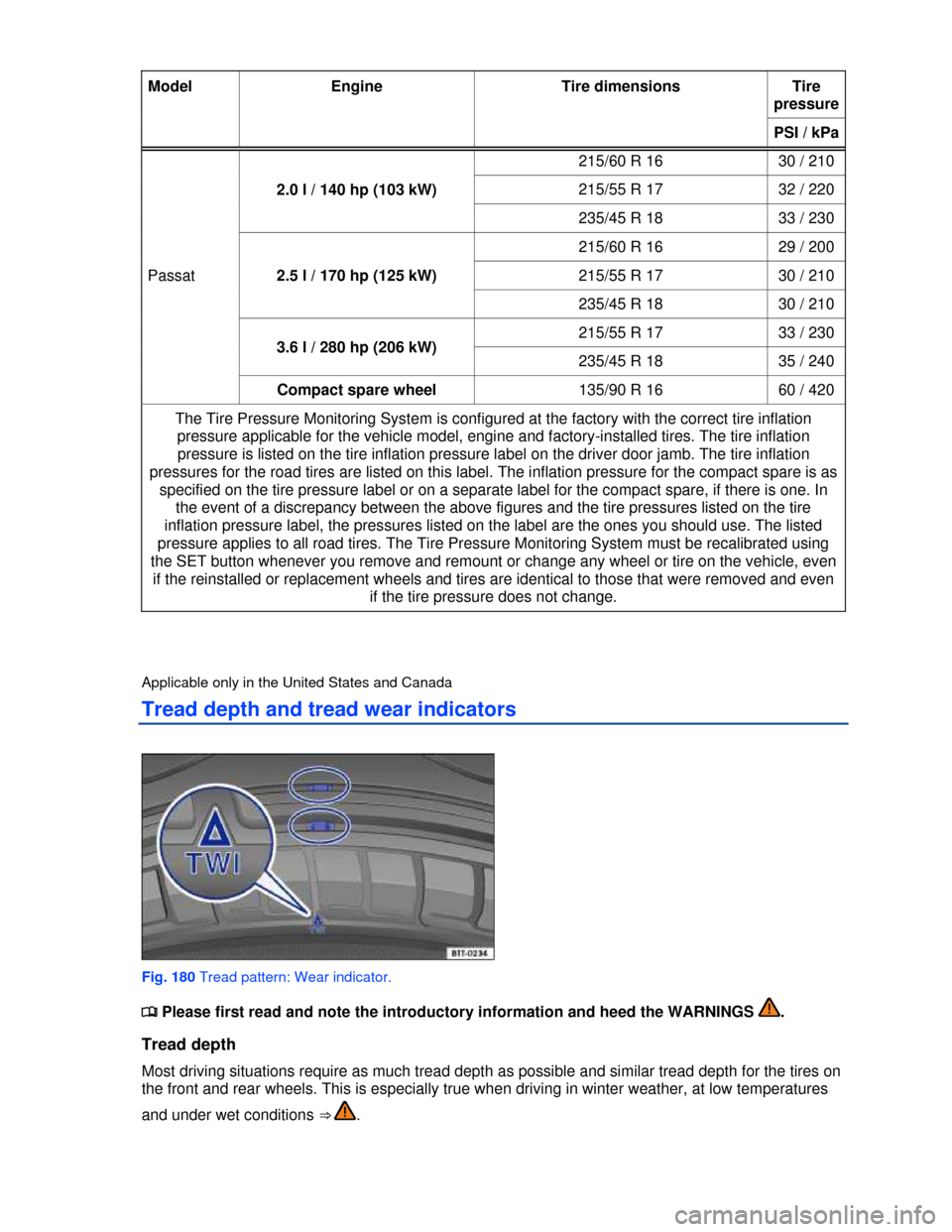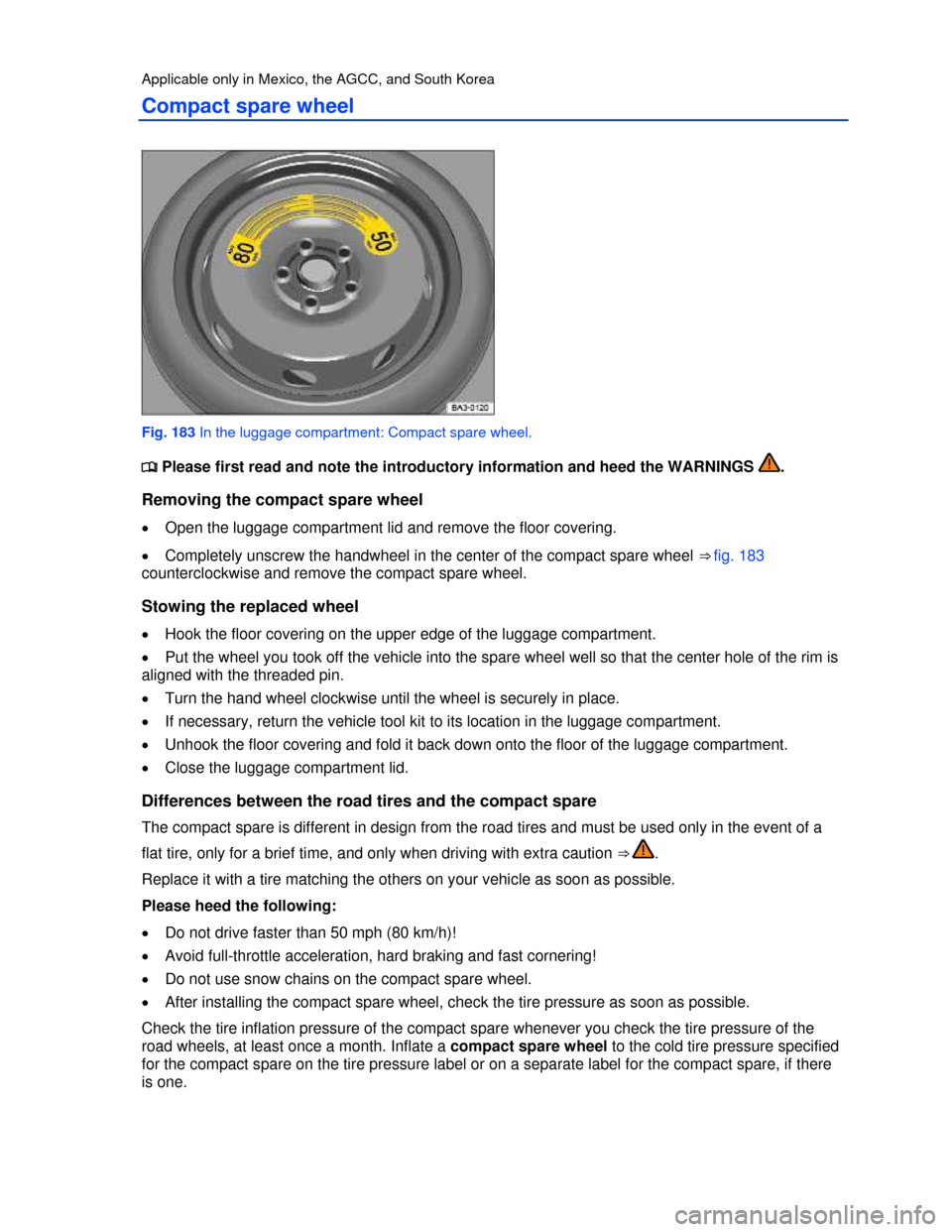2013 VOLKSWAGEN PASSAT spare wheel
[x] Cancel search: spare wheelPage 290 of 379

Tire inflation pressure in cold tires
Tread depth and tread wear indicators
Tire wear and damage
Compact spare wheel
Tire labeling
Tire efficiency label
Winter tires
Snow chains
Glossary of tire and loading terminology
Tires and vehicle load limits
Determining the correct load limit
Volkswagen recommends that all work on tires and wheels be done by an authorized Volkswagen
dealer or authorized Volkswagen Service Facility. They are familiar with the technical requirements
and recommended procedures, have the necessary special tools and spare parts, and can properly
dispose of old tires.
More information:
�x Transporting
�x Trailer towing
�x Braking, stopping and parking
�x Tire Pressure Monitoring System
�x Exterior care and cleaning
�x Vehicle tool kit
�x Consumer information
�x Wheel covers
�x Changing a wheel
Page 293 of 379

Rotating tires
To help ensure even wear on all tires, regular tire rotation according to the diagram ⇒ fig. 176 is
recommended. In this way all tires can have about the same service life.
Volkswagen recommends that you have your tires rotated by an authorized Volkswagen dealer or
authorized Volkswagen Service Facility.
Tires more than 6 years old
Tires age even if they are not being used. Physical and chemical processes reduce tire strength and
performance and cause them to harden and become brittle. Old tires can fail suddenly and without
warning.
Volkswagen recommends replacing tires that are 6 years and older. This also applies to tires that look
new (including the tire on the compact spare wheel) or that seem to still be usable with tread depth
that has not yet reached the legal minimum depth ⇒ .
The age of each tire can be determined with the manufacturing date that is part of the U.S DOT tire
identification number (TIN).
Tire storage
Mark tires before removing them to help make sure that the previous location (left, right, front, rear)
and rolling direction can be maintained when remounting them. Store tires in a cool, dry and preferably
dark place. Do not store tires mounted on wheels standing up.
Tires not mounted on wheels should be covered to help protect them from dirt and stored vertically
(sitting on the tread).
WARNING
Aggressive fluids and materials can cause visible and invisible tire damage that can cause
tire blowouts.
�x Always keep chemicals, oils, grease, fuels, braking fluids and other aggressive
substances away from tires.
WARNING
Tires age even if they are not being used and can fail suddenly, especially at high speeds,
causing loss of vehicle control, accidents, and severe personal injuries.
�x Tires that are more than 6 years old can be used only in an emergency and even then only
with special care and at low speed.
Always dispose of old tires in accordance with legal requirements.
Page 295 of 379

Rotating tires
To help ensure even wear on all tires, regular tire rotation according to the diagram ⇒ fig. 177 is
recommended. In this way all tires can have about the same service life.
Volkswagen recommends that you have your tires rotated by an authorized Volkswagen dealer or
authorized Volkswagen Service Facility.
Tires more than 6 years old
Tires age even if they are not being used. Physical and chemical processes reduce tire strength and
performance and cause them to harden and become brittle. Old tires can fail suddenly and without
warning.
Volkswagen recommends replacing tires that are 6 years and older. This also applies to tires that look
new (including the tire on the compact spare wheel) or that seem to still be usable with tread depth
that has not yet reached the legal minimum depth ⇒ .
The age of each tire can be determined with the manufacturing date that is part of the U.S DOT tire
identification number (TIN).
Tire storage
Mark tires before removing them to help make sure that the previous location (left, right, front, rear)
and rolling direction can be maintained when remounting them. Store tires in a cool, dry and preferably
dark place. Do not store tires mounted on wheels standing up.
Tires not mounted on wheels should be covered to help protect them from dirt and stored vertically
(sitting on the tread).
WARNING
Aggressive fluids and materials can cause visible and invisible tire damage that can cause
tire blowouts.
�x Always keep chemicals, oils, grease, fuels, braking fluids and other aggressive
substances away from tires.
WARNING
Tires age even if they are not being used and can fail suddenly, especially at high speeds,
causing loss of vehicle control, accidents, and severe personal injuries.
�x Tires that are more than 6 years old can be used only in an emergency and even then only
with special care and at low speed.
Always dispose of old tires in accordance with legal requirements.
Applicable only in the United States and Canada
Wheel rims
�
Page 299 of 379

Model Engine Tire dimensions Tire
pressure
PSI / kPa
Passat
2.0 l / 140 hp (103 kW)
215/60 R 16 30 / 210
215/55 R 17 32 / 220
235/45 R 18 33 / 230
2.5 l / 170 hp (125 kW)
215/60 R 16 29 / 200
215/55 R 17 30 / 210
235/45 R 18 30 / 210
3.6 l / 280 hp (206 kW) 215/55 R 17 33 / 230
235/45 R 18 35 / 240
Compact spare wheel135/90 R 16 60 / 420
The Tire Pressure Monitoring System is configured at the factory with the correct tire inflation
pressure applicable for the vehicle model, engine and factory-installed tires. The tire inflation
pressure is listed on the tire inflation pressure label on the driver door jamb. The tire inflation
pressures for the road tires are listed on this label. The inflation pressure for the compact spare is as
specified on the tire pressure label or on a separate label for the compact spare, if there is one. In
the event of a discrepancy between the above figures and the tire pressures listed on the tire
inflation pressure label, the pressures listed on the label are the ones you should use. The listed
pressure applies to all road tires. The Tire Pressure Monitoring System must be recalibrated using
the SET button whenever you remove and remount or change any wheel or tire on the vehicle, even
if the reinstalled or replacement wheels and tires are identical to those that were removed and even
if the tire pressure does not change.
Applicable only in the United States and Canada
Tread depth and tread wear indicators
Fig. 180 Tread pattern: Wear indicator.
�
Page 303 of 379

Wheel alignment – Incorrect wheel alignment causes excessive and uneven tire wear, impairing
vehicle safety. If you notice excessive or uneven tire wear, have the wheel alignment checked by an
authorized Volkswagen dealer or authorized Volkswagen Service Facility.
WARNING
Unusual vibrations or pulling to one side can indicate tire damage.
�x Reduce speed immediately and stop when it is safe to do so.
�x Check tires and wheel rims for damage.
�x Never drive with a damaged tire or rim. Get expert assistance instead.
�x If no external damage is visible, slowly and carefully drive to the nearest authorized
Volkswagen dealer or authorized Volkswagen Service Facility or other qualified workshop
and have the vehicle checked.
Applicable only in the United States and Canada
Compact spare wheel
Fig. 182 In the luggage compartment: Compact spare wheel.
�
Page 304 of 379

�x Do not drive faster than 50 mph (80 km/h)!
�x Avoid full-throttle acceleration, hard braking and fast cornering!
�x Do not use snow chains on the compact spare wheel.
�x After installing the compact spare wheel, check the tire pressure as soon as possible.
Check the tire inflation pressure of the compact spare whenever you check the tire pressure of the
road wheels, at least once a month. Inflate a compact spare wheel to the cold tire pressure specified
for the compact spare on the tire pressure label or on a separate label for the compact spare, if there
is one.
WARNING
Improper use of a compact spare wheel can cause loss of vehicle control, a crash or other
accident, and serious personal injury.
�x Never use a compact spare wheel if it is damaged or worn down to the wear indicators.
�x In some vehicles, the compact spare wheel is smaller than the original tire. A smaller
compact spare wheel is identified with a sticker and the words “50 mph” or “80 km/h.” This is
the maximum permissible speed when driving with this tire.
�x Never drive faster than 50 mph (80 km/h) with a compact spare wheel. Avoid full-throttle
acceleration, heavy braking, and fast cornering!
�x Never drive more than 125 miles (200 km) if a compact spare wheel is installed on the front
axle (drive axle).
�x Replace the compact spare with a normal wheel and tire as soon as possible. Compact
spare tires are designed for brief use only.
�x Regularly check the U.S. DOT Tire Identification Number (TIN) to determine the age of the
compact spare wheel. Tires age even if they are not being used and can fail suddenly,
especially at higher speeds.
�x Tires that are more than 6 years old can only be used in an emergency and then with
special care and at lower speeds.
�x The compact spare wheel must always be secured with the wheel bolts provided by the
factory.
�x Never drive using more than one compact spare wheel.
�x After installing the compact spare wheel, the tire pressure must be checked as soon as
possible.
�x Snow chains cannot be used on the compact spare wheel. If you must use snow chains
and have a compact spare wheel mounted, move the compact spare wheel to the rear axle if a
front tire has to be replaced. The tire taken off the rear axle can then be used to replace the
flat front tire. Be sure you do not change the tire's direction of rotation. Install the snow
chains on the full-sized road tire.
NOTICE
When the spare wheel or compact spare is being used, the TPMS indicator light can come on
after a couple of minutes.
If possible, attach the compact spare wheel or the tire you took off the vehicle securely in the
luggage compartment.
Page 305 of 379

Applicable only in Mexico, the AGCC, and South Korea
Compact spare wheel
Fig. 183 In the luggage compartment: Compact spare wheel.
�
Page 306 of 379

WARNING
Improper use of a compact spare wheel can cause loss of vehicle control, a crash or other
accident, and serious personal injury.
�x Never use a compact spare wheel if it is damaged or worn down to the wear indicators.
�x In some vehicles, the compact spare wheel is smaller than the original tire. A smaller
compact spare wheel is identified with a sticker and the words “50 mph” or “80 km/h.” This is
the maximum permissible speed when driving with this tire.
�x Never drive faster than 50 mph (80 km/h) with a compact spare wheel. Avoid full-throttle
acceleration, heavy braking, and fast cornering!
�x Never drive more than 125 miles (200 km) if a compact spare wheel is installed on the front
axle (drive axle).
�x Replace the compact spare with a normal wheel and tire as soon as possible. Compact
spare tires are designed for brief use only.
�x Regularly check the U.S. DOT Tire Identification Number (TIN) to determine the age of the
compact spare wheel. Tires age even if they are not being used and can fail suddenly,
especially at higher speeds.
�x Tires that are more than 6 years old can only be used in an emergency and then with
special care and at lower speeds.
�x The compact spare wheel must always be secured with the wheel bolts provided by the
factory.
�x Never drive using more than one compact spare wheel.
�x After installing the compact spare wheel, the tire pressure must be checked as soon as
possible.
�x Snow chains cannot be used on the compact spare wheel. If you must use snow chains
and have a compact spare wheel mounted, move the compact spare wheel to the rear axle if a
front tire has to be replaced. The tire taken off the rear axle can then be used to replace the
flat front tire. Be sure you do not change the tire's direction of rotation. Install the snow
chains on the full-sized road tire.
NOTICE
When the spare wheel or compact spare is being used, the TPMS indicator light can come on
after a couple of minutes.
If possible, attach the compact spare wheel or the tire you took off the vehicle securely in the
luggage compartment.